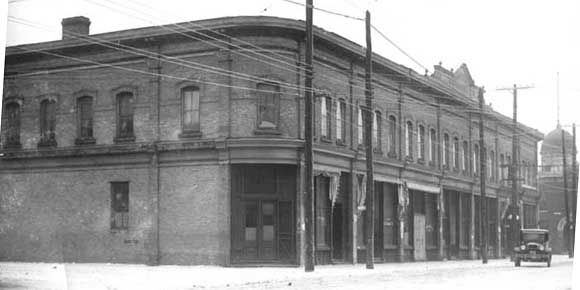by Bruce Cherney (part 1)
On November 13, 1941, the Shanghai Chop Suey House opened on King Street, and would stay open for the next 70 years serving a myriad of satisfied customers. A year later, the building was demolished to make way for the site’s redevelopment as an assisted-living seniors’ complex. At the time of its opening, the landmark Shanghai restaurant on the main floor of the two-storey brick and stone Coronation Block stood in the very heart of Winnipeg’s six-block Chinatown district.
What also made the building unique is that when it was completed in 1883, its main floor served as the temporary accommodations for city council until 1886 while the famous “Gingerbeard” City Hall was under construction.
But the Coronation Block, 228-238 King St., originally called the Robert Block and built by Winnipeg businessman John Higgins, also had an infamous past. While it was divided into rooms as one of Winnipeg’s many lodging (boarding) houses, tragedy struck during the Christmas season of 1927. A headline in the December 29, 1927, Winnipeg Free Press proclaimed, Poison Liquor Addicts have Lives Snuffed Out in Gruesome Building. As a result of wood alcohol poisoning, 11 men perished and another was blinded after drinking the deadly concoction then referred to as either “dynamite” or “canned heat.”
While it was a great tragedy, the poisonings in the Coronation Block directly led to much needed changes in how lodging/boarding houses operated in the city.
At the time of the poisonings, the ground floor was occupied by two Chinese stores referred to in newspapers as “chop” houses since food was also served by the bowl, while the upper floor was “divided by thin partitions into many rooms wherein the hobo or itinerant workman down on his luck may obtain a ‘ten-cent flop,’” according to the Free Press.
The stores on the ground floor were said in the report to be not “materially” different than others in the vicinity. “But upstairs it is different — so different from anything the average citizen of Winnipeg has ever imagined, different from anything that even social welfare workers find in their investigations — different by reason of the fact that it is not merely squalid poverty that has left its stamp on the premises but that therein may be found the earmarks of unorthodox dissipation, degeneracy and crime.”
Both of the city’s daily newspapers painted a rather bleak picture of the accommodations in the 34 rooms of the lodging house.
According to the December 29 Free Press: “On each side of the hallway, doors open into rooms. On the front of the room are the 25 cent rooms; at the back are the 10 centers. They are of two sizes. In the smaller ones are three ‘beds;’ in the larger ones, four ‘beds.’
In the beds are men asleep. There are no sheets or blankets. The men are covered by old, torn and filthy rags. The walls are discolored. In places the plaster is gone and the laths stick out like the ribs of a skeleton. An old bureau stands against one wall. It is completely bare and has no mirror. The window is thick with dirt.”
The consumption of wood alcohol (also referred to as methanol or methyl hydrate) was a carryover from the days of prohibition in the province. Although prohibition ended in Manitoba by 1923, stringent regulations still made it difficult for the poor to obtain legal alcoholic beverages.
Winnipeg Mayor Ralph Humphreys Webb declared that for every hotel and club legally selling beer there were hundreds of “blind pigs” located in houses, apartments, business blocks and boarding houses selling whiskey illegally in the city (Winnipeg Free Press, January 15, 1927). At the time, Manitobans could only legally purchase hard liquor from government stores for consumption in their homes.
“There is a large illicit liquor trade in Winnipeg,” reported the Winnipeg Tribune on November 10, 1930, “and it would be much larger if it was not kept in check by the boys of the morality squad.”
Home brew peddlers were said to be operating in the “poorer” areas of the city.
“Poor people who can’t afford legal liquor can buy (a) ‘pop’ bottle of home-brew for 50 cents. This usually runs about 150 per cent proof spirits, which is nearly four times stronger than ordinary whiskey or gin.”
Inspector W.H. Stubbs, the enforcement officer for the Canadian excise prevention service, had a display he called “Poison Row” in his office. The row of poisonous liquor had been seized during raids. Most of the lethal liquor was distilled from vehicle anti-freeze and tincture of iodine.
The tincture of iodine was shipped in 40-gallon casks from a well-known Eastern Canadian manufacturer. The tincture, which contained 90 to 95 per cent of low-grade alcohol, was placed outside in the winter to freeze, which separated the iodine from the alcohol.
Then the spirit was added to quantities of anti-freeze — consisting of commercial-grade alcohol, glycerine and water. “The whole mess was then put into the boilers and the alcohol in it distilled. Even after the redistillation this questionable stuff, when poured upon white paper, stains it the iodine brown. The results of drinking this stuff as whiskey may be left to the imagination” (Tribune, January 2, 1924).
Much of the so-called liquor was shipped south by rumrunners for consumption by Americans who were in the midst of their own prohibition, which didn’t end until 1933, but some stayed behind to satisfy the demand of the poorer sections of Winnipeg.
The home distillation of spirits became the new business practice for bootleggers due to the Manitoba government’s liquor control commission raising the price of “good” liquor bought in the province.
(Next week: part 2)



